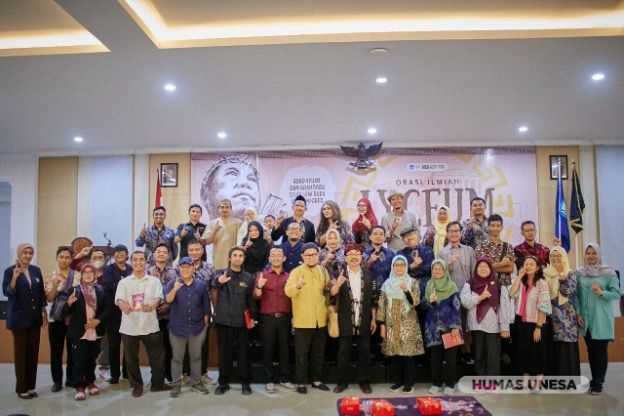
UNESA professor of fine arts, Djuli Djatiprambudi presents various phenomena of technological progress and contemporary human tendencies from the perspective of fine arts.
Unesa.ac.id. SURABAYA—Lecturer and professor of fine arts at Surabaya State University (UNESA), Djuli Djatiprambudi gave a scientific oration in a forum entitled "Lyceum" at the T2 Building Auditorium, Faculty of Languages and Arts (FBS), Lidah Wetan Campus II, on Thursday, December 12 2024.
This activity, which was attended by students and lecturers from undergraduate to postgraduate degrees in Fine Arts at UNESA, carried the theme "The Century of Visual and New Directions for the Study of Contemporary Art."
Coordinator of the Doctoral Program in Art Education, Setyo Yanuartuti, said that this scientific oration was a forum for broadening horizons and strengthening knowledge in the field of art and fine arts.
"Through this activity, it is hoped that the community will be inspired to better understand and follow the development of art in this modern era, both for research and application needs," he hoped.
In the oration session, Djuli Djatiprambudi discussed the fundamental shifts that have occurred in the fine arts paradigm in the era of globalization and revolution in the 21st century.
According to him, contemporary art is no longer assessed only from an aesthetic perspective, but also as a form of understanding and responding to global issues, including social, technological and cultural changes.

This scientific oration was attended by leadership, lecturers and FBS UNESA fine arts or arts education students.
He called this era " Visual Age", where logic, reason becomes more dominant than essence. Therefore, fine arts must be inter/multi/transdisciplinary.
Fine art has now become a forum for combining creativity, reflection and critical analysis that encompasses various sciences, from philosophy to digital technology.
Several modern art phenomena such as NFT (Non-Fungible Token), augmented reality-based art, and crypto art are clear evidence that fine art has entered a new era full of innovation.
"With this development, we must be aware of the importance of maintaining a balance between local values and global market demands," he said.
Indonesian fine arts, with its rich traditions and culture, has a strategic position to be able to compete in the global art market. However, this requires more capital to be able to make local art take part in the global arena.
According to the Tuban-born professor, there are three aspects of art creation. First, the formal aspect as the form and content of knowledge that characterizes works of art.
Second, the aspect of experience as physical and mental involvement in the basic object of knowledge. Third, methodological aspects as logical principles that are manifested in procedures for achieving ideas and empirical manifestations of ideas.
As a large part of Surabaya State University, he hopes that this institution can continue to play an active role in developing fine arts education based on creativepreneurship.
Through collaboration between artists, academics and society at large, contemporary art can be a reflection of complex human experiences as well as a catalyst for significant social change.[*]
***< /p>
Reporter: Septiarafi Gusti Putra (FBS)/Davayessy (FBS)
Editor: @zam*
Photo: UNESA PR Team
Share It On:






